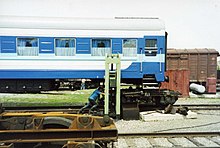Bogie exchange
Bogie exchange is a system for operating railway wagons on two or more gauges to overcome difference in the rail gauge. It is generally limited to wagons and carriages, though engines can be exchanged if more time is available.
Wagons and carriages
Wagons can have their gauge changed by lifting them off one set of bogies and putting them back down again on another set of bogies. The pin that centres the bogies and the hoses and fittings for the brakes must be compatible. There needs to be a generous supply of bogies of each gauge to accommodate the ebb and flow of traffic.
The bogies and wagons also need to have standardized hooks, etc, where they may be efficiently lifted.
Engines
Steam
Steam engines can be designed for more than one gauge by having reversible wheel hubs that suit two alternative gauge. This was done in the 1930s and beyond in Victoria for possible gauge conversion, though no engines were ever converted in this manner. Some 1 Garratt locomotives of East Africa were designed for easy conversion to 42 Cape gauge.
Diesel
Diesel locomotives have bogies like wagons and carriages, only with more cables for the traction motors and take a little longer to convert. In Australia, some classes of diesel locomotives are regularly gauge-converted to suit traffic requirements on the 1435 mm, 1600 mm and 1067 mm networks.
Raising or lowering
Raise
The simplest way to carry out bogie exchange is the lift the wagons off the wheels and replace them back on new bogies. This may require the wagons in a train to be uncoupled, and continuous brakes disconnected. As the bogies are swung out of the way, they sway, which wastes time settling them down.
Lower
A cleverer way of carrying out bogie exchange is to lower the bogies onto a trolley in a pit, after which the trolleys are rolled out of the way and others return. This keeps the train couplings and continuous brakes connected. In addition, the bogies never need leave a solid surface, so that they can be wheeled in and out more quickly. This method was used at Adelaide. [1]
International
Argentina
- Between 1,435 mm (4 ft 8+1⁄2 in) standard gauge and 66
Australia
Between 1961 and 1995, Australia had five bogie exchange centres, which opened and closed as gauge conversion work proceeded. The gauges served were 1435 mm and 1600 mm, though the 1067 mm Queensland did acquire 100 bogie-exchange compatible QLX wagons just in case. All the wagons involved had wagon codes ending in "X", such as VLX.
The centres were:
- Dynon, Melbourne, Victoria
- Wodonga near Albury on state border.
- Port Pirie, South Australia
- Peterborough, South Australia
- Dry Creek, Adelaide, South Australia - the youngest and most modern. [2] [3] [4]
Belarus
- Brest, Belarus – between 1520 mm and 1435 mm at the border to Poland
Bolivia
Bogie exchange used between 762 mm and 1000 mm gauge on the Ferrocarril de Antofagasta a Bolivia Railway.
Canada
- Between 1,435 mm (4 ft 8+1⁄2 in) standard gauge and the 42 gauge of the former Newfoundland Railway (Terra Transport) at Port aux Basques
China

A bogie exchange station exist at the Chinese border to Mongolia. Both the Moscow-Peking passenger train (Trans-Siberian) and freight trains get their bogies exchanged. Mongolia has Russian gauge (1520 mm), China has 1435 mm.
Finland
A bogie exchange station exist in the port of Turku. Freight cars get their bogies exchanged. Train ferries go from Germany and Sweden. They carry no passenger trains, and passengers must walk on and off ferries, and need a bus transfer to the railway station. Finland has Russian gauge.
Iran
Kazakhstan
 Druzhba, KZ -
Druzhba, KZ -  Alashankou, CN.
Alashankou, CN.
Peru
- Between 1,435 mm (4 ft 8+1⁄2 in) standard gauge and 36 on the Ferrocarril Central Andino
Russia


 Ussuriisk (near Vladivostok) with North Korea and China.
Ussuriisk (near Vladivostok) with North Korea and China.
Spain
- At Irun, between 1,435 mm (4 ft 8+1⁄2 in) and 1668 mm
- At Port Bou, between 1,435 mm (4 ft 8+1⁄2 in) and 1668 mm
Tunisia
- Between 1,435 mm (4 ft 8+1⁄2 in) standard gauge and 1000
Ukraine
- Chop, Ukraine – between 1520 mm and 1435 mm at the border to Hungary and Slovakia
See also
- SeaRail
- Qazaqstan Temir Zholy
- Mungindi railway line
- Transporter wagon - and its logical development, the transporter train.
- Ramsey Car Transfer Apparatus
- Variable gauge axles is quicker and is starting to replace bogie exchange.
- Wheelset
Links
References
- ^ Catch Point - November 2007 - p35 - picture of lowering method
- ^ http://www.trainweb.org/mystation/gauge1.txt
- ^ [Ian Patterson & Partners]
- ^ Technology in Australia 1788-1988, Chapter 7, page 477
